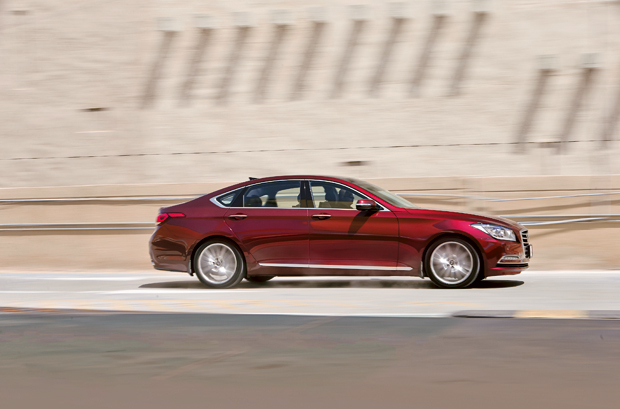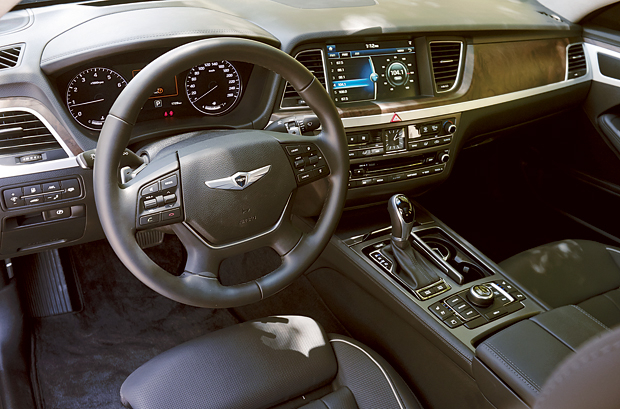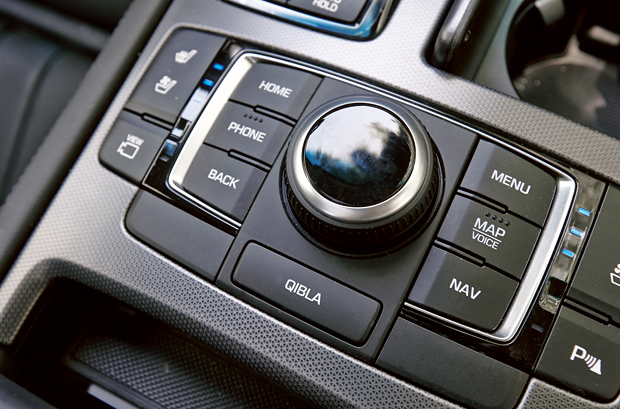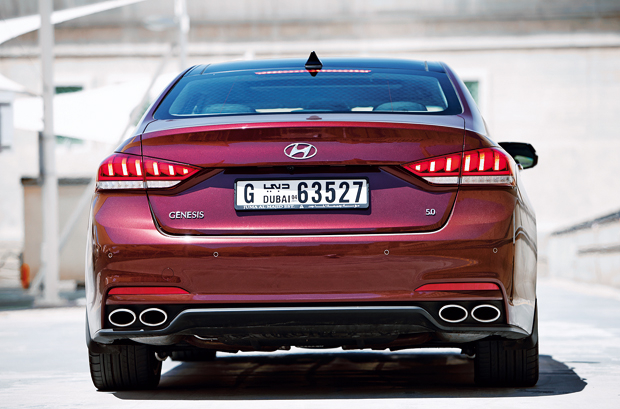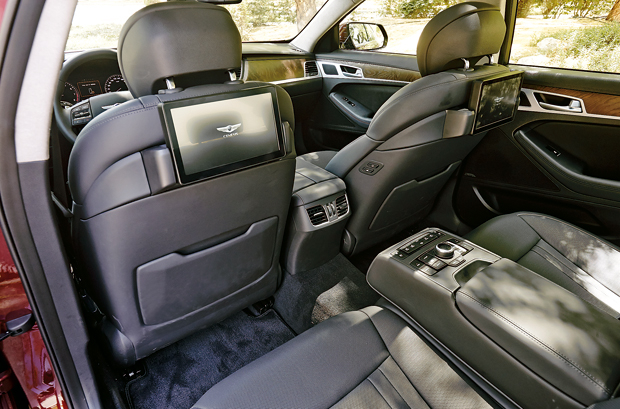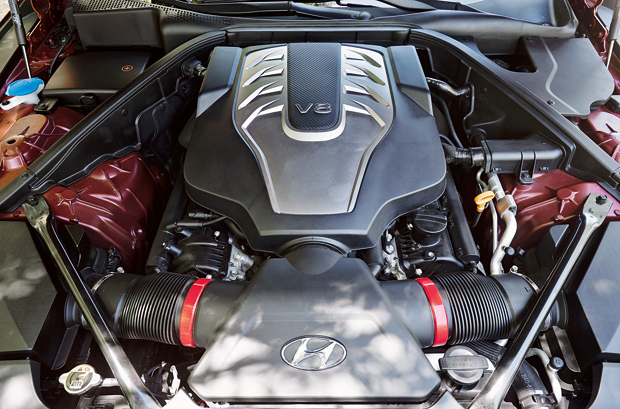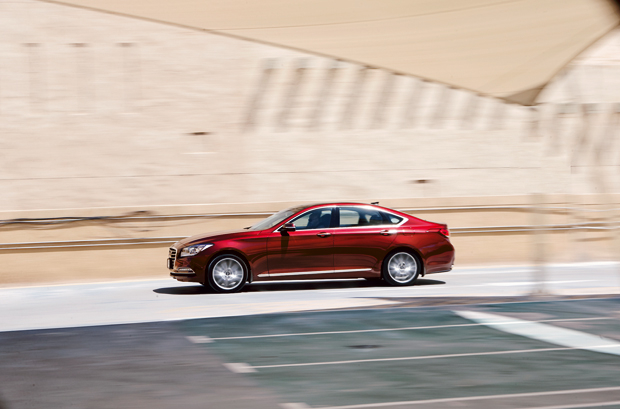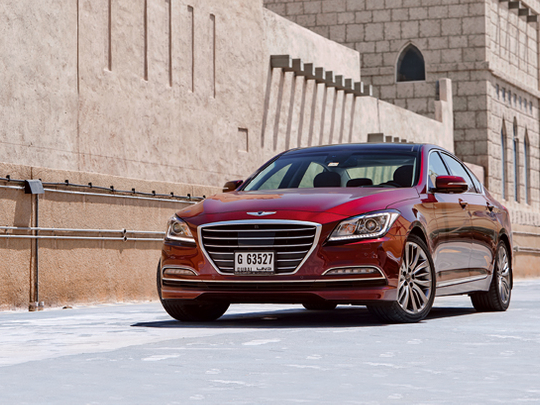
Hyundai’s efforts to establish itself as a serious contender in the premium car market got the first significant push back in 2008 when it launched the Genesis saloon. With that car, the Korean carmaker took the world by surprise and pipped veteran saloons to win scores of accolades, including the North American Car of the Year award in 2009.
However, as good as it was, the Genesis saloon still had a few rungs to climb to get into the same league as premium German and Japanese brands in terms of technology, refinement and build quality. It’s these issues that the South Korean giant is seeking to iron out with its all-new 2015 Genesis, launched here just a few weeks ago.
The first-generation Genesis was pretty flat in terms of styling, with none of the swoops and creases that characterised the rest of Hyundai’s line-up. The 2015 model, which debuts Hyundai’s ‘Fluidic Sculpture 2.0’ styling concept, is also quite restrained in design but manages to look sharper, with many more distinctive lines than the previous model.
Thanks to its increased dimensions and the imposing hexagonal grille, the Genesis has a pompous air about it that no other car in the price range can boast. Those with a keen eye for detail could point out that certain elements of the car’s exterior styling are derivative, like the Bentley-ish winged badge up front and the BMW 7 Series-like beltline. But whether inspired or not, all these elements seem to blend remarkably well in the Genesis to give it a modern, dignified appearance.
However, Hyundai appears to be confused whether to market this car as a separate premium brand like Lexus and Infiniti or not. This is apparent in the half-hearted attempt at distancing the car from the parent brand by sticking a Genesis badge on the grille, the alloy wheels, the steering wheel and the side sills, but retaining a lone Hyundai badge on the bootlid. This is baffling as it contradicts Hyundai’s insistence that it’s proud to take on the Germans, the Japanese and the Americans without establishing a separate premium badge. I see it as a missed opportunity for Hyundai, as this was the car that could’ve elevated the brand’s image by association.
Meanwhile, the cabin too gets a thorough revamp, with good-quality real wood and aluminium trim and perforated leather seats lending it a luxurious ambience overall. However, the quality of switchgear and the sensible but not-so-attractive layout take some sheen off the otherwise fine interior. But this is adequately compensated by the class-leading head- and legroom and the plush and supportive seats that are on a par with those in leading premium brands that carry much larger price tags.
It’s also impressively quiet, with barely any tyre roll or wind noise creeping in. The only sound that sneaks past the cabin insulation is the rumble from the 5.0-litre V8 under the bonnet, which is the same that impressed us in the larger Centennial. Pushing out 420bhp and 520Nm of torque in the top-spec Genesis, the eight-cylinder powerhouse hauls the bulky limo with the greatest of ease.
Acceleration is smooth and steady, and the self-assured manner in which it gathers pace befits the car’s stately bearing. It feels more agile and planted than the previous model, with the chassis and suspension offering an ideal mix of litheness and luxury. The brakes, however, feel a bit grabby for a luxury car.
There’s no missing the fact that Hyundai has come a long way with its steering technology. The variable-ratio, electric-assisted steering is better weighted and more responsive than before, and I can safely say that this is by far the most confidence-inspiring Hyundai I’ve ever driven — the Genesis coupé included.
It’s still got some way to go before it matches the 5 Series or the CTS in terms of athleticism, but Hyundai engineers have definitely managed to close the previously wide gap considerably with the new Genesis.
It’s not just looks and driving dynamics that have improved in the 2015 Genesis. It now comes with a feature set that’s comparable to any available in a more expensive German or Japanese limousine, like head-up display, power-adjustable cooled seats front and back, a panoramic glass roof, adaptive cruise control that works like a dream and lane-departure warning system that alerts you by vibrating the steering wheel, just to state a few from the long list.
If the first Genesis saloon improved Hyundai’s stature in the industry, the new one has effectively propelled it into a different league. This is the closest a Hyundai has ever come to matching a BMW or Mercedes in terms of refinement, power, performance and features.
Hyundai is clearly aiming to eat into market shares in different segments by offering a loaded car the size of a 7 Series and powered by a 5.0-litre V8 for the price of a 3 Series. In fact, you can get a 3.8-litre V6-engined version for as little as Dh152,800. And if you’re still not convinced by the Hyundai nameplate, the Korean carmaker has made it easy for you by leaving just one badge at the back to be replaced.


